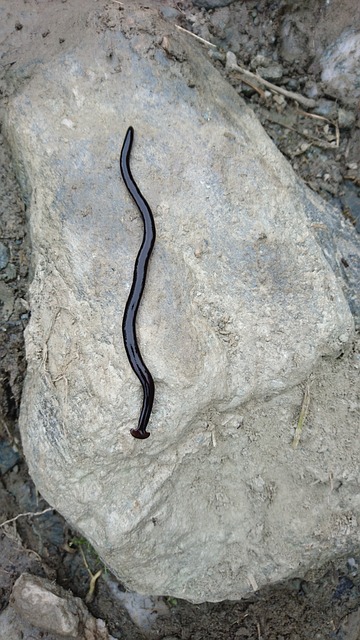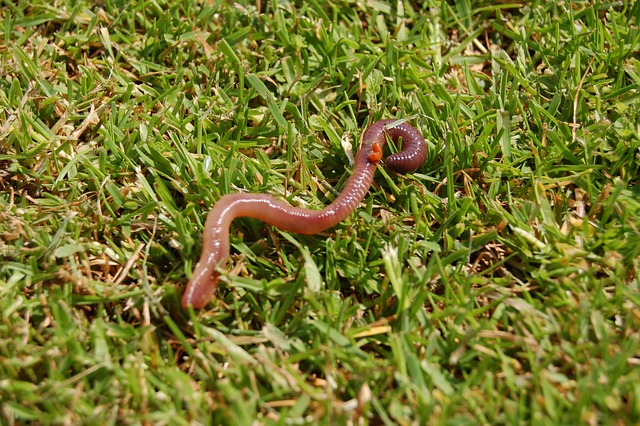If I were to say to you, “hammerhead,” what would be the first thing you think of? Most likely you thought of the distinctive hammerhead shark. But what if I were to tell you it’s not the only “hammerhead” animal around? And even stranger, this other “hammerhead” could be in your yard right now. So what is it, and is it as intimidating as the nearly 20 feet long great hammerhead shark? Well, the good news is that it is significantly smaller and toothless, but the bad news is that it’s toxic and a potentially dangerous predator; it’s the hammerhead flatworm.

What do Hammerhead Flatworms Look Like?
Much as their name suggests, these creatures have a head shaped like the notorious hammerhead shark, except it’s a bit more rounded than the sea-dwelling hammerhead. Hammerhead flatworms (Bipalium kewense) are terrestrial flatworms that can grow up to 15 inches long, though they are generally more like 8 to 12 inches in length. They have a snake-like, narrow body, which is generally a honey color with between 1 and 5 dark stripes running along their back and a dark partial collar.

Where do Hammerhead Flatworms Live?
Hammerhead flatworms are natively from Southeast Asia but have been an invasive species in the U.S. since at least 1901. These pests are notorious hitchhikers and are believed to have originally found their way to our shores with horticultural plants and have since thrived in greenhouses and in other hot, humid locations. Currently, they can be found outdoors in 9 states, and yes, one of those is definitely Texas. And they are still a well-known hitchhiker, so be sure to check for them in supplies of landscaping, mulch, and nursery plants.
These pests will be found almost exclusively outdoors. Most days they can be found in areas of high shade and moisture. Some common examples are under rocks, under fallen leaves, under logs, under shrubs, and even under leaking or dripping garden spigots. On some occasions, like after a heavy Texas rainstorm, they can be found in the same sorts of places you might see earthworms after a deluge: on sidewalks, driveways, and on top of the soil in your yard. Since they are sensitive to light, they are active primarily during the night.
What Exactly is an Invasive Species?
The U.S. Department of Agriculture defines an invasive species as: “an alien species whose introduction does or is likely to cause economic or environmental harm or harm to human health.” In short, they are non-native species (whether plant or animal) that have been so successful here that they are dangerous to our ecosystem, agricultural businesses, or to human health. For more on some common Texas invasive species, see our articles on crazy ants, murder hornets, stink bugs, and ghost ants.

What do Hammerhead Flatworms Eat?
If the appearance of these pests hasn’t creeped you out, just wait till you find out how the carnivorous hammerhead flatworms eat. When they find their prey, they wrap around it, surrounding it in a sticky mucus, and then use special enzymes that digest the prey before they ever consume it. Once the enzymes have done their work, and their prey is essentially just goo, the hammerhead flatworm sucks in its meal using its mouth which is located in the middle of its body on its belly. To add to the horrific image, remember that this is all happening during the dark nighttime.
So which creatures are unfortunate enough to end up as hammerhead flatworm food? They are most notorious for their predation of earthworms, but they are also known to regularly prey upon other small invertebrate organisms like slugs, and snails; on occasion, they will also consume insects like pill bugs and springtails.

Are Hammerhead Flatworms Dangerous?
The short answer here is “yes,” hammerhead flatworms are harmful in several different ways. Of biggest concern is their ecological impact due to their predation of earthworms. As you probably already know, earthworms are vital for the health of our soil, and the health of our soil depicts the well-being of our crops, forests, gardens, yards, and even our compost piles. So if the hammerhead flatworm thrives in an area, it can end up posing a real threat to all plants in the vicinity.
In addition, they secrete chemicals through their skin as both a defense mechanism and to aid in digestion, these chemicals can cause skin irritation on people if they hold the hammerhead flatworm and on pets if they consume it. In fact, these pests produce tetrodotoxin; if this sounds familiar, it is the infamous substance that makes puffer fish deadly. Fortunately, they produce it in such small amounts that a single hammerhead flatworm doesn’t pose a real threat to people or pets from this toxin. Though if your pet does consume one, it’s likely to be sick for a day. Finally, as a flatworm, these pests can have parasitic nematodes within them, which could potentially cause health issues for you or your pets if you come in contact with them.
How do you Prevent Hammerhead Flatworms?
Unfortunately, there is no real way to prevent these pests from invading your yard and garden. In terms of preventing these pests from thriving in Texas, the best thing to do is to contact the Texas Invasive Species Institute at invasives@shsu.edu with a picture and your coordinates to aid in their study of the issue.

How do you Eliminate Hammerhead Flatworms?
At the moment, the elimination of hammerhead flatworms has to be done on an individual scale, meaning that each flatworm has to be found and killed separately. There is currently research into pest control methods that would allow for the elimination of these flatworms without risk to earthworm populations, so if you see a hammerhead flatworm in your yard, give The Bug Dude a call at 817-354-5350 to see what we can do to help you.
If you do encounter a hammerhead flatworm the most important thing is that you do not try to chop it up with a garden shovel or any other instrument. These pests reproduce by fragmentation, which means that a portion of the worm naturally pinches off and within about 10 days that portion will become an entirely new worm. So if you chop the worm in half, you aren’t killing it, you’re just making 2 hammerhead flatworms to have to contend with.
So what do you do if you find one of these pests in your yard? First, using gloves, a stick, or a paper towel, pick up the worm and place it in a Ziploc bag. If you are not willing or able to do this, do your best to enclose the worm in some sort of container so that it cannot simply wriggle away, and call The Bug Dude at 800-310-BUGS (2847). If you have enclosed the worm in a Ziploc bag, contact The Bug Dude and the Texas Invasive Species Institute, and once that is done, you can kill the worm by pouring either salt or vinegar in the bag with the worm, sealing it up, and throwing it away. Be sure to thoroughly wash your hands after your encounter with this worm.
If you’re like most people, you probably hadn’t heard of the hammerhead flatworm before today, much less knew what it looked like. But if you’re living in the DFW metroplex, then you know that you can always call The Bug Dude at 817-354-5350 about any strange pest you find lurking around your home or yard and our expert staff will do everything we can to help identify and eliminate your pest woes. So whether it’s a hammerhead flatworm or a fire ant, at the first sign of a pest problem, give The Bug Dude a call.
Further Reading:
“Hammerhead Flatworm/Hammerhead Slug” – Texas Invasive Species Institute
Invasive Hammerhead Flatworms: Invasive hammerhead flatworms found in Lamar County” – Jennifer Whitlock, Field Editor, Texas A&M AgriLife Extension
“Hammerhead Worms Are Toxic and Invasive, But Are They Dangerous?” – Jesslyn Shields, HowStuffWorks
“Invasive Species Definition Clarification and Guidance” – National Invasive Species Information Center – U.S. Department of Agriculture
“Invasive, toxic worms are back in Texas due to recent rains, summerlike warmth” – Andrew Wulfeck, FOX Weather
“Invasive hammerhead flatworms spotted in Texas” – Kelsey Thompson, KXAN
“Meet Your New Nightmare, the Hammerhead Worm” – Rose Cahalan, TexasMonthly
Author Bio: Alissa Breach has been gaining knowledge and experience around pest control concerns over the last 13 years while working for Mid-Cities Pest Control. She has a creative writing BA from UW-Madison and is always pursuing new and interesting writing projects.




